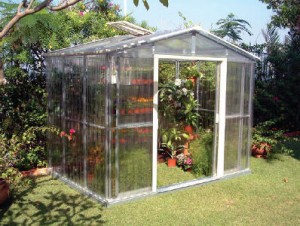
Pretty much everyone can recognize a greenhouse. The sight of a framed structure with transparent walls and roofing is quite distinctive, even to those less familiar with what a greenhouse is. While the most common modern methods for constructing greenhouses didn't begin until the mass production of polyethylene film in the 1960's, the modern greenhouse has existed since it's introduction in Italy in the 13th century. In fact, we can find evidence of greenhouse-like cultivation methods as early as the Roman Empire, where gardeners of Emperor Tiberius invented methods for the year long production of the emperor's favorite cucumber-like vegetable. But how does a greenhouse actually work? You probably wouldn't have selected this blog if you already knew, but don't worry, you're about to find out!
The purpose of a greenhouse is to artificially provide a suitable environment for plants to grow at times of the year or in locations they would not otherwise grow. In other words, if you want to start growing pineapples during December in Maryland, a greenhouse is virtually the only way you are going to successfully accomplish this. The primary way a greenhouse allows plants to grow year round is by sustaining heat. Basically, radiation and heat from the sun is trapped inside the house in a controlled manner. As sunlight enters through the glass or plastic roofing, the soil and plants inside begin to warm. As the warm air rises, it is replaced by cooler air which then warms as well, allowing the greenhouse to maintain a much warmer microclimate than the air on the outside. In certain areas, the sunlight is strong enough and long enough to provide for a majority, if not entirety, of the necessary heat. In other areas, however, a significant amount of heat must be generated to keep the greenhouse at a suitable temperature.
In these houses, natural gas, bottled gas, heating coils, heating fans, a central heating system, or some other method is employed to provide the necessary heat. For smaller greenhouses harboring more basic crops, a simple thermostat is all that's necessary in order to regulate the temperature. For larger greenhouses or those housing more complex crops, intensive computer systems must be installed and regularly monitored in order to ensure the crops are successfully brought to harvest. As might be imagined, heating is the primary cost in operating a greenhouse, and new, cheaper methods for heating are constantly being explored.
Another major factor in the operation of a greenhouse, ironically enough, is a proper cooling system. While the plants will not grow without enough heat, too much heat can kill them or interfere with the photosynthesis process. Generally, vents are used to allow the hotter air at the top to escape while cycling in cooler air near the ground, properly conditioning the environment and keeping the CO2 levels suitably circulated. These vents will typically be mechanized on some level, opening and closing as temperatures rise and fall in the house.
And of course, you can't grow plants without water. The method that water is distributed will vary greatly based on the size of the greenhouse and the resources of the owner. Methods range from a simple hose to massive drip irrigation systems. Ultimately, the combination of proper heating, proper cooling, and proper water distribution is all you need to operate a successful greenhouse.
Call now or fill out the box below